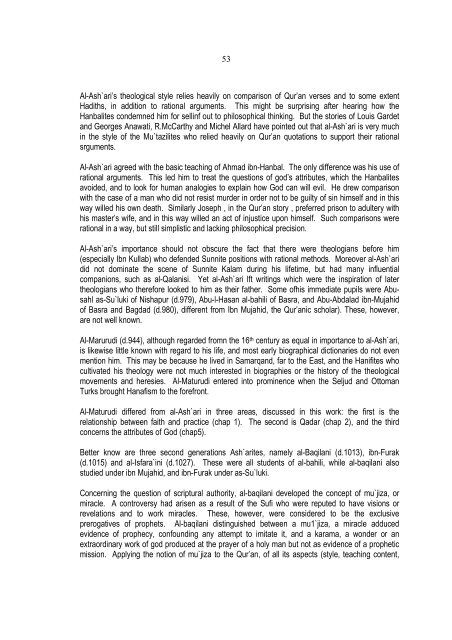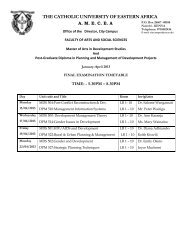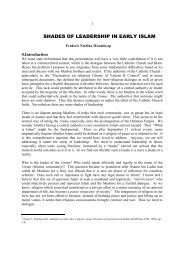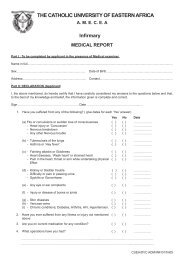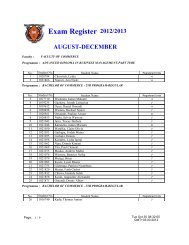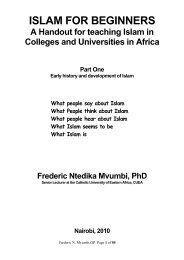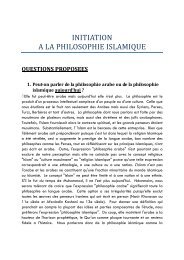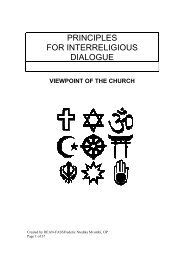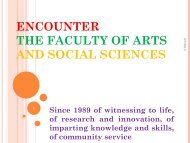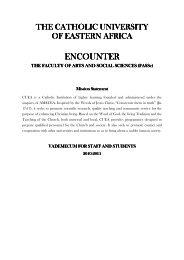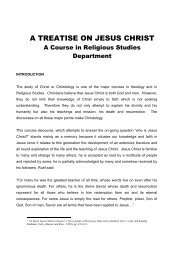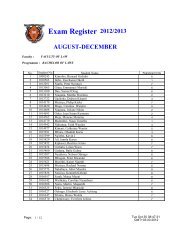INTRODUCTION TO ISLAMIC THEOLOGY.pdf - CUEA
INTRODUCTION TO ISLAMIC THEOLOGY.pdf - CUEA
INTRODUCTION TO ISLAMIC THEOLOGY.pdf - CUEA
You also want an ePaper? Increase the reach of your titles
YUMPU automatically turns print PDFs into web optimized ePapers that Google loves.
53Al-Ash`ari’s theological style relies heavily on comparison of Qur’an verses and to some extentHadiths, in addition to rational arguments. This might be surprising after hearing how theHanbalites condemned him for sellinf out to philosophical thinking. But the stories of Louis Gardetand Georges Anawati, R.McCarthy and Michel Allard have pointed out that al-Ash`ari is very muchin the style of the Mu`tazilites who relied heavily on Qur’an quotations to support their rationalsrguments.Al-Ash`ari agreed with the basic teaching of Ahmad ibn-Hanbal. The only difference was his use ofrational arguments. This led him to treat the questions of god’s attributes, which the Hanbalitesavoided, and to look for human analogies to explain how God can will evil. He drew comparisonwith the case of a man who did not resist murder in order not to be guilty of sin himself and in thisway willed his own death. Similarly Joseph , in the Qur’an story , preferred prison to adultery withhis master’s wife, and in this way willed an act of injustice upon himself. Such comparisons wererational in a way, but still simplistic and lacking philosophical precision.Al-Ash`ari’s importance should not obscure the fact that there were theologians before him(especially Ibn Kullab) who defended Sunnite positions with rational methods. Moreover al-Ash`aridid not dominate the scene of Sunnite Kalam during his lifetime, but had many influentialcompanions, such as al-Qalanisi. Yet al-Ash`ari lft writings which were the inspiration of latertheologians who therefore looked to him as their father. Some ofhis immediate pupils were Abusahlas-Su`luki of Nishapur (d.979), Abu-l-Hasan al-bahili of Basra, and Abu-Abdalad ibn-Mujahidof Basra and Bagdad (d.980), different from Ibn Mujahid, the Qur’anic scholar). These, however,are not well known.Al-Marurudi (d.944), although regarded fromn the 16 th century as equal in importance to al-Ash`ari,is likewise little known with regard to his life, and most early biographical dictionaries do not evenmention him. This may be because he lived in Samarqand, far to the East, and the Hanifites whocultivated his theology were not much interested in biographies or the history of the theologicalmovements and heresies. Al-Maturudi entered into prominence when the Seljud and OttomanTurks brought Hanafism to the forefront.Al-Maturudi differed from al-Ash`ari in three areas, discussed in this work: the first is therelationship between faith and practice (chap 1). The second is Qadar (chap 2), and the thirdconcerns the attributes of God (chap5).Better know are three second generations Ash`arites, namely al-Baqilani (d.1013), ibn-Furak(d.1015) and al-Isfara`ini (d.1027). These were all students of al-bahili, while al-baqilani alsostudied under ibn Mujahid, and ibn-Furak under as-Su`luki.Concerning the question of scriptural authority, al-baqilani developed the concept of mu`jiza, ormiracle. A controversy had arisen as a result of the Sufi who were reputed to have visions orrevelations and to work miracles. These, however, were considered to be the exclusiveprerogatives of prophets. Al-baqilani distinguished between a mu1`jiza, a miracle adducedevidence of prophecy, confounding any attempt to imitate it, and a karama, a wonder or anextraordinary work of god produced at the prayer of a holy man but not as evidence of a propheticmission. Applying the notion of mu`jiza to the Qur’an, of all its aspects (style, teaching content,


